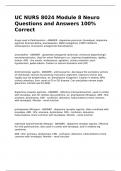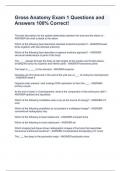UC NURS 8024 Module 8 Neuro
Questions and Answers 100%
Correct
drugs used in Parkinsonism - ANSWER - dopamine precursor (levodopa), dopamine
agonists (bromocriptine, pramipexole), MAOI (selegiline), COMT inhibitors
(entacopone), muscarinic antagonists (benztropine)
amantadine - ANSWER - glutamate antagonist (antiviral), enhances dopaminergic
neurotransmission. Used for minor Parkinson's sx, improves bradykinesia, rigidity,
tremor. ADE - dry mouth, restlessness, agitation, urinary retention, post.
hypotension, pedal edema. Caution in seizure disorders and CHF!
Anticholinergic agents - ANSWER - antimuscarinic, decreases the excitatory actions
of cholinergic neurons by blocking muscarinic repectors. Improves tremor and
rigidity but not bradykinesia. ex: benztropine (Cogentin). Caution in elderly, BPH,
urinary retention, liver, renal or GI or GU disease. Can precipitate narrow angle
glaucoma. Limited use d/t ADEs
dopamine receptor agonists - ANSWER - effective mild parkinsonism, used in combo
with levodopa. also for restless leg syndrome. ex: pramipexole (Mirapex). ADE - N/V,
anorexia, dyskinesias, CNS - confusion, delusions, hallucinations (more common
with levodopa). Monitor - renal function
pramipexole (Mirapex) - ANSWER - dopamine receptor agonist, often combined with
levodopa. ADE - N/V, anorexia, dyskinesias, CNS - confusion, delusions,
hallucinations (more common with levodopa). Monitor - renal function
ropinirole hydrocholoride (Requip) - ANSWER - dopamine receptor agonist. effective
for mild parkinsonism, also used in combo with levodopa, and in restless leg
syndrome.
ADE - N/V, anorexia, dyskinesias, CNS - confusion, delusions, hallucinations (more
common with levodopa). Monitor - renal function
, monamine oxidase B inhibitors - ANSWER - MOA not fully understood. ex: selegiline
(Eldepryl), rasagiline (Azilect). used in early Parkinson's disease, mild sx, usually
given with levodopa. No tyramine foods! ADE - insomnia, mood changes,
dyskinesias, GI sx, hypotension. Do not combine with fluoxetine or meperidine -
additive effect!
Dopamine precursors - ANSWER - enhances synthesis of dopamine. levodopa and
carbidopa (Sinemet). works best in new patients. over time, number of neurons
decreases. relief lasts only while drug is present in body. Give levodopa in
combination with carbidopa to increase levadopa availability
Levadopa - ANSWER - dopamine precursor. attempts to replace dopamine. Can
cross BBB. rapid GI absorption, short half life. On-off phenomenon - sudden loss of
normal mobility, tremors. Take levodopa on empty stomach to increase CNS
availability - meals (esp high protein) interferes with levodopa transport in CNS
carbidopa - ANSWER - dopamine precursor. enhances effect of levadopa by
diminishing metabolism of levadopa in GI tract and peripheral tissues. Increases
availability of levadopa to cross into CNS.
levodopa/carbidopa combination - ANSWER - potent and effective in treatment.
carbidopa increases bioavailability of levodopa - more CNS availability. levodopa
decreases rigidity and tremors. typical decline in response in 3rd to 5th year of tx.
levodopa ADEs - ANSWER - GI sx, tachycardia, PVCs, postural hypotension,
mydriasis (can precipitate glaucoma). CNS effects: hallucinations, dyskinesias,
mood changes, depression, psychosis, anxiety. CI in hx of psychosis
clonazepam (Klonopin) - ANSWER - benzodiazepine. used in absence seizures,
myoclonic seizures, infantile spasms. ADE - sedation, additive effect with ETOH, liver
metabolized, CYP450 interactions
phenobarbital - ANSWER - barbiturate, oldest AED. used for partial and generalized
tonic-clonic seizures, status, febrile seizures, DOC for neonatal seizures. ADE -
sedation, cognitive issues, ataxia, hyperactivity, CYP450 interactions.





